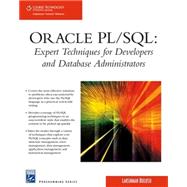
| Introductory Concepts | |
| Introduction 5 pages | |
| PL/SQL by dissection 20 pages | |
| Program Structure Internal Representation Memory Usage | |
| Program Compilation | |
| Program Execution Meta-data for PL/SQL code | |
| Program Debugging Protecting Source Code | |
| New features in PL/SQL 10 pages | |
| New features in Oracle10g | |
| New features in Oracle11g | |
| Techniques for PL/SQL Programming | |
| Data Structure Management in PL/SQL 30 pages | |
| Techniques for using Records | |
| Techniques for using Associative Arrays | |
| Techniques for using Nested Tables | |
| Techniques for using VARRAYS Simulating Multi-Dimensional Arrays | |
| Techniques for using Objects as Data Structures Records vs Objects | |
| Error Management in PL/SQL 20 pages | |
| Techniques to obtain complete error info | |
| Techniques to customize error info returned | |
| Techniques to halt further processing on error occurrence | |
| Data Management in PL/SQL 40 pages | |
| Data Retrieval Techniques | |
| Data Manipulation Techniques | |
| Dynamic SQL and PL/SQL techniques | |
| Array Processing using static SQL | |
| Array Processing using dynamic SQL | |
| Techniques for using DDL in PL/SQL | |
| Application Management in PL/SQL 40 pages | |
| Procedures Vs Functions | |
| When to use what | |
| User-defined operators Vs Functions | |
| When to use what Coding packages to globalize data and code | |
| Packages vs Contexts | |
| When to use what to globalize data | |
| Reading and Writing package variables dynamically | |
| Coding packages to localize data and privatize code | |
| Coding packages to break dependency chain Coding packages to pass data between applications | |
| Sharing data using collections vs sharing data using | |
| REF CURSORS Supplementing application logic with data integrity using triggers | |
| Packages Vs Objects as application structures | |
| Transaction management in PL/SQL 15 pages | |
| Asynchronous COMMIT | |
| Autonomous transaction techniques | |
| Techniques for auditing queries | |
| Applying PL/SQL in the real world | |
| Application Development Frameworks using PL/SQL | p. 40 pages |
| Application Development | |
| Framework Error Handling | |
| Framework DML Auditing | |
| Framework File I/O | |
| Framework ETL | |
| Framework Performance Tuning Framework | |
| Applying PL/SQL in 3GL and Web environment 30 pages | |
| Extending PL/SQL to use Java | |
| Extending PL/SQL to use C and C++ | |
| Extending PL/SQL to use HTML | |
| HTML in PL/SQL vs PL/SQL in HTML | |
| Emailing techniques in PL/SQL UTL_MAIL vs UTL_SMTP | |
| When to use what | |
| Miscellaneous Techniques 20 pages | |
| Simulating datasets using pipelined table functions | |
| Auto-generating code using dynamic | |
| SQL and/or PL/SQL Hiding statically written and dynamically generated PL/SQL Code | |
| Batch Scheduling of OS command jobs | |
| PL/SQL Tuning and Debugging 30 pages | |
| Tuning Data Structures | |
| Tuning Procedural Code | |
| Techniques for Debugging PL/SQL | |
| PL/SQL Coding Standards 10 pages | |
| Table of Contents provided by Publisher. All Rights Reserved. |
The New copy of this book will include any supplemental materials advertised. Please check the title of the book to determine if it should include any access cards, study guides, lab manuals, CDs, etc.
The Used, Rental and eBook copies of this book are not guaranteed to include any supplemental materials. Typically, only the book itself is included. This is true even if the title states it includes any access cards, study guides, lab manuals, CDs, etc.